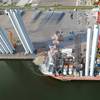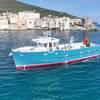STX Finland Oy and Ministry of Fisheries and Marine Resources of the Republic of Namibia have, on 11.2.2011, signed a contract for the construction of a fisheries research vessel. The ship, with a contract value of approximately EUR 35 million, will bring some 250 man-years of labour to STX Finland’s Rauma shipyard, with delivery scheduled for spring 2012. This versatile specialized vessel will be approximately 62 metres long and will provide accommodation for 45 crew members and research personnel.
The research vessel is specifically designed for the purposes of Namibian fisheries research. The vessel meets the latest standards set for this type of vessels requiring, in particular, special care in the design of laboratory equipment, propulsion and power generation system. The vessel also has very high overall technical standards and special attention has been given to the vessel’s serviceability and low maintenance costs. Furthermore, the ship features a dynamic positioning system and it is operational in any African sea and weather condition in all seasons with no restrictions.
The tasks of the research vessel include monitoring of fish stock, as well as sorting, processing, freezing and storage of fish. The multi-purpose specialized vessel will also be used for collecting biological samples for seabed research and analysis and provide assistance for control of fishing. The vessel also features facilities for meteorological research.
“This order is very important for STX Rauma shipyard. The contract now signed shows that the shipyard has succeeded very well in its long-term research and development efforts focused on specialized vessels,” said Timo Suistio, Director of STX Rauma shipyard. “The R&D will continue with the construction of the research vessel now ordered by Namibia. In the design we can apply the same technologies as in the icebreaker for research purposes ordered by theSouth African Department of Environmental Affairs, to be delivered in 2012, since the two vessels, to a certain extent, carry out similar tasks and use the same kind of equipment. In the case of the fisheries research vessel, the areas for further development include enhanced hydroaccoustic characteristics and hull protection techniques.”












